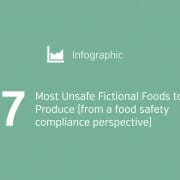Food Fraud: Challenges and Strategies
Food fraud has become an ever-growing problem that affects products and businesses across the supply chain, and in the UK alone, it has been said to have cost industry over £11 billion, and as much as $40 billion in the USA.
Food fraud occurs when products are deliberately mislabeled or misrepresented, diluted, tampered with, substituted, counterfeited, or subjected to unapproved enhancements.
The pronounced effect of this is that food fraud is a complex commercial and supply chain issue that is not something that can be solved by a Quality or Technical department alone.
A brief history of fraud
There are many reasons why fraud occurs from a desire to increase profit margins or the product itself being cheap and easy to copy, to unsatisfied market demands, and difficulties in detecting and proving the providence of a good, which in some cases can make it easier to carry out.
‘Horsegate’, in 2013, was one of the most publicized cases that pushed food fraud to the forefront of media attention in recent years.
When testing on frozen beef burgers first revealed undeclared equine DNA, it soon became evident that affected products had been disseminated throughout the supply chain and resulted in several European countries being affected in the fallout.
This fallout was significant, yet it was not the first, nor is it likely to be the last, instance of food fraud on a significant scale that garners worldwide attention.
In separate instances, in both 2007 and 2008, melamine originating from China was found to have a presence in pet food and baby formula, highlighting what can happen when the motivation of profit exceeds product integrity.
When the motivation of profit exceeds product integrity… surely no economic gain can be worth such an outcome.
Included to show adequate protein content after water had been added to raw milk to increase its volume, the contamination with baby formula led to many illnesses and the deaths of 6 infants, surely no economic gain be worth such an outcome.
What motivates food fraud?
Recent scandals such as these have further highlighted the need for companies to provide mitigation strategies within their organizations and across their supply chain to help reduce food fraud.
Typically, it may be best practice to conduct a vulnerability risk assessment of the supply chain, which usually includes looking at 3 main aspects: Opportunities, Motivations, and Mitigations.
For any given food product or ingredient, the nature of its composition, qualities, production process and supply chain, as well as its geographic origin, determine the opportunity for fraud.
For example, it is generally easier to commit fraud on liquid products and complex foods with more ingredients than simpler foods with fewer ingredients.
When assessing the opportunity of food fraud occurring to the product, questions that should be asked include:
- How complex is the supply chain of the product?
- How robust is the security along the supply chain?
- How easily can adulteration be detected?
- What detection methods are available?
Perhaps, Professor Chris Elliot of Queen’s University Belfast, Ireland, put this best when he remarked that “every time you have a transaction, there’s another opportunity to cheat.”
“Every time you have a transaction, there’s another opportunity to cheat.”
At its core, what this means is that food fraud can potentially occur at any stage in the food supply chain, and we must be vigilant at all times to its potentiality.
Once an ‘opportunity’ is identified throughout the chain that fraud may occur, it is equally as important to consider ‘why’ this might occur in the first instance.
Once an ‘opportunity’ is identified throughout the chain that fraud may occur, it is equally as important to consider ‘why’ this might occur in the first instance.
Once the motivation for fraud can be considered, it can determine at which stage fraud will more likely occur and what additional steps can be taken to mitigate against its occurrence.
Asking yourself the questions, how would you describe the economic conditions of your direct suppliers and how would you rate the corruption level of your suppliers, will be a step forward in helping to identify the motivation of food fraud through your supply chain.
Basic economic motivation can be classified as one of the main reasons for food fraud and this can be driven by revenue maximization or cost minimization.
Economic motivation can be driven by revenue maximization or cost minimization.
Once any motivation has been identified you need to put in place mitigation strategies to help prevent this potential fraud from occurring.
Mitigation strategies for food fraud
The best prevention against food fraud is to anticipate the reasons why it may occur, both internal and external, and to mitigate against them.
A necessity for a food business is to fully understand each of the stakeholders in the chain involved in producing, storing, and distributing their food ingredients.
A common struggle for companies is Supply Chain Mapping, which is extremely relevant in paving the way to help reduce food fraud.
Effective procurement, robust supplier approval, and supplier management are core elements to minimize any potential supply chain risks.
Not only is the management of your supply chain vital, but a company also needs to start from within their facility by looking at their food safety management system, management itself, and employees, which all play an important role in reducing the risk of food fraud.
A company needs to start from within their facility.
It’s important to consider employee integrity screening and an ethical code of conduct, and to not forget that employees and staff are at the forefront of production every day.
Those at the front line need to be comfortable if they see anything abnormal happening, i.e., potential food fraud, that you as a company have policies in place that protect them if they come forward to discuss.
Being able to track your raw material right from the beginning of its life and knowing the supply chain between then and when it arrives to you is also paramount, so an effective and strong traceability and mass balance system should be in place as well.
A robust supplier approval process is key, and it is important to really think about what standards you want your supplier to have.
This was previously discussed in one of our more recent blogs (What criteria can you use to risk assess your suppliers?), and it should take into consideration their ethical code of conduct.
Going further, you may also want to consider if there are any whistleblower policies in place, even if this means asking questions to staff during an audit to help assess whether they may think any strange activities may be happening.
Lastly, along with the above, we cannot forget raw material monitoring and testing (with a representative sample) is an important aspect in the fight against potential food fraud, although this may not always be easy.
Testing may not always be easy, and can be expensive, time-consuming and a large representative sample would be required to just rely on this strategy alone.
Food fraud in the future
I believe it is safe to say at this moment there are industry-wide challenges when it comes to the detection of potential food fraud.
It is certain that food fraud is an ever-growing concern for all those involved in the food industry, and can occur at multiple points and from multiple sources, with a wide array of motivations.
Widespread opportunity, adulteration and deception, as well as the ever-growing complexity of the supply chain, makes our lives somewhat more difficult, but equally as rewarding.
Widespread opportunity makes our lives somewhat more difficult, but equally as rewarding.
Those committing food fraud are criminals and deception is their main goal, so they will do everything they can to hide that this is happening, and therefore, this will make it more challenging.
We need to be vigilant and determined within the food industry to fight against this fraud and we need to learn from previous public food fraud cases, I would imagine that no one would want to face the repercussions of such a scandal to their company and damaging effects to consumers.
An article I read previously stated ‘Criminals are smarter than Salmonella’, and at this moment in the food industry, this is probably something many could agree with.
One mitigation strategy alone will not help to combat this fight, but rather a multi-faceted proactive approach, transparent systems, and constant vigilance is required at all times.











Leave a Reply
Want to join the discussion?Feel free to contribute!